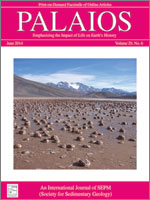Previous studies of the sequence stratigraphic distribution of fossils have focused on the record of relatively abundant marine invertebrates. Only a handful of studies have examined how sequence stratigraphic architecture influences the occurrence of vertebrates, particularly large and rare tetrapods. The Jurassic Sundance Formation of the Bighorn Basin, Wyoming, USA, contains a rich suite of invertebrate and vertebrate fossils, including large and rare marine reptiles, and this allows the sequence stratigraphic controls on the distribution of these groups to be compared. The Sundance Formation consists of four depositional sequences, with the lower two being carbonate dominated and the upper two siliciclastic dominated. Two incised valley fills are also present. The presence of multiple depositional sequences and strongly erosional sequence boundaries is the likely cause of the complicated lithostratigraphic nomenclature of the Sundance. Invertebrates (mollusks and echinoderms) in the Sundance conform to well-established patterns of occurrences, including strong facies control and fossil concentrations at maximum flooding surfaces, in the upper portion of parasequences, and within lags overlying sequence boundaries. As expected from their rarity, marine reptiles (ichthyosaurs, plesiosaurs, and pliosaurs) show a weaker connection to sequence stratigraphic architecture. Nonetheless, they do display facies control and are found primarily in offshore mudstone, rather than shoreface and estuarine sandstone. They are also more common at hiatal surfaces, including a zone of concretions at the maximum flooding surface and in lag deposits overlying sequence boundaries. These associations suggest that sequence stratigraphic architecture may be a useful approach for discovery of marine vertebrates and that sequence stratigraphic context should be considered when making paleobiological interpretations of marine vertebrates as well as invertebrates.
How to translate text using browser tools
1 June 2014
THE OCCURRENCE OF VERTEBRATE AND INVERTEBRATE FOSSILS IN A SEQUENCE STRATIGRAPHIC CONTEXT: THE JURASSIC SUNDANCE FORMATION, BIGHORN BASIN, WYOMING, U.S.A
SHARON K. MCMULLEN,
STEVEN M. HOLLAND,
F. ROBIN O'KEEFE
ACCESS THE FULL ARTICLE
It is not available for individual sale.
This article is only available to subscribers.
It is not available for individual sale.
It is not available for individual sale.

PALAIOS
Vol. 29 • No. 6
June 2014
Vol. 29 • No. 6
June 2014




